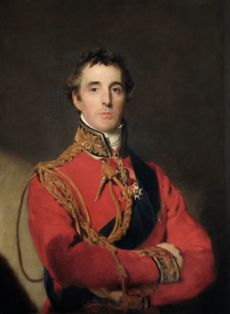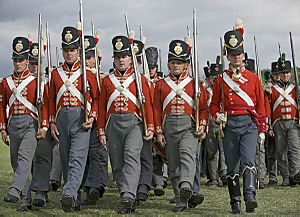Battle of San Millan-Osma facts for kids
Quick facts for kids Battles of San Millán and Osma |
|||||||
|---|---|---|---|---|---|---|---|
| Part of Peninsular War | |||||||
|
|||||||
| Belligerents | |||||||
| Commanders and leaders | |||||||
| Strength | |||||||
| San Millan: 4,800 Osma: 3,800–4,802 |
San Millan: 4,000–5,484 Osma: 1,200–4,854 |
||||||
| Casualties and losses | |||||||
| San Millan: 400 Osma: 120 |
San Millan: 100 Osma: 50–60 |
||||||
The Battles of San Millán and Osma happened on June 18, 1813, in Spain. These were two small but important fights during the Peninsular War. This war was part of the bigger Napoleonic Wars across Europe. In these battles, soldiers from Britain, Portugal, and Spain (called the Allied army) fought against the French army.
At a village called San Millán de San Zadornil, a group of Allied soldiers, known as the Light Division, surprised and defeated a French division. About 7.4 kilometers (4.6 miles) away, at Osma, another French division had a short fight with an Allied division. The French then pulled back. These battles were important because they weakened the French army just before a much bigger battle.
In the summer of 1813, the Allied army, led by Lord Wellington, moved into Spain from Portugal. Wellington was a very clever general. He outsmarted the French, forcing them to leave cities like Salamanca, Valladolid, Madrid, and Burgos. The French king, Joseph Bonaparte, and his general, Jean-Baptiste Jourdan, thought they were safe behind the Ebro River. But Wellington sent his troops around their northern side, surprising them.
During this move, the French divisions at San Millán and Osma were caught off guard. The French division at San Millán was badly beaten. King Joseph thought this division was too damaged to fight well anymore. So, he sent it to guard a supply convoy. This meant they missed the very important Battle of Vitoria just three days later.
Contents
Why These Battles Happened
After fighting in 1812, Wellington's army was tired, with many soldiers sick. But they had also won some big victories, capturing important cities and areas in Spain. Plus, 5,000 new soldiers arrived from Britain.
At the same time, Emperor Napoleon's army had suffered huge losses in Russia. To rebuild his army in Germany, Napoleon ordered many soldiers to leave Spain and join him. This weakened the French army in Spain. King Joseph was left with about 95,000 soldiers, divided into three main armies.
However, Spanish fighters, called guerrillas, were causing a lot of trouble for the French in northern Spain. They would attack French soldiers and disrupt their supplies. Napoleon was very worried about these guerrilla attacks. He ordered a large part of the French army to focus on stopping them.
One example of a guerrilla attack happened on March 30, 1813. A Spanish guerrilla leader named Francisco Espoz y Mina ambushed a French group. Out of 1,500 French soldiers, only a few escaped, and 663 were captured. While the French were busy fighting these guerrillas, Wellington's Allied army was getting ready for a big attack.
Wellington's Big Attack
Even though Napoleon thought Wellington only had a small army, Wellington was actually marching with a huge force. He had 52,000 British, 28,000 Portuguese, and 25,000 Spanish soldiers. This was a total of over 100,000 troops!
Wellington divided his army into two main groups. One group, led by General Hill, marched northeast. The other group, led by General Graham, crossed a river called the Douro.
The French king, Joseph, and his general, Jourdan, thought Wellington would attack them head-on. But Wellington had a different plan. He sent his armies around the French positions, surprising them. On May 26, General Hill's group captured Salamanca. On June 2, General Graham's group took Zamora.
On June 2, British cavalry also won a small but important fight at Morales de Toro. They defeated a French cavalry force, capturing many soldiers. By June 3, Wellington had gathered 90,000 troops, while the French only had 51,000. Realizing they were outnumbered, Joseph and Jourdan quickly retreated towards Burgos.
Wellington continued his clever flanking move. The French expected him to follow the main road, but he kept his armies marching to the north of it. This made the French very confused. On June 13, the French had to abandon Burgos, even blowing up their own castle there. Wellington was secretly changing his supply base from Lisbon to Santander, on the coast, which was much closer to his new position.
During this retreat, more French soldiers joined King Joseph's army. However, another 25,000 French troops were still far away, fighting guerrillas. Joseph believed his army was safe behind the Ebro River. But Wellington's troops crossed the Ebro on June 15, completely outflanking the French. For several days, the French had no idea where Wellington's huge army was.
Battle at Osma
King Joseph found out that a Spanish group was threatening Bilbao. So, he sent a French general named Reille with three divisions north on June 18. Reille's soldiers soon ran into General Graham's part of the Allied army.
At Osma, one of Reille's divisions, led by General Jacques Thomas Sarrut, met General Howard's Allied division. Sarrut had about 3,800 men. Howard's division included about 1,200 soldiers from the King's German Legion (KGL). In this fight, the French lost about 120 soldiers, either killed or wounded. The KGL units lost about 50 to 60 soldiers. After this clash, Reille's forces retreated south to join Joseph's main army.
Battle at San Millán
On June 18, 1813, General Antoine Louis Popon de Maucune's French division, with about 4,800 men, was stopped at the village of San Millán de San Zadornil. The leading group of Wellington's Light Division, led by General John Ormsby Vandeleur, attacked them from the west.
As Vandeleur's men pushed the French out of the village, Maucune's second group of soldiers appeared from a rocky area. They were behind Vandeleur's men. But before the French could take advantage, another Allied group, led by General James Kempt, arrived. Kempt immediately attacked. To avoid being surrounded, Maucune's second group had to leave the road and retreat across the hills.
Vandeleur noticed what was happening. He quickly sent some of his soldiers to attack the French second group from another side. Under this pressure, Maucune's soldiers broke apart and ran away.
Maucune's division lost about 400 soldiers in total. Around 300 of them were captured, along with their supplies. The British lost about 100 soldiers. As the French soldiers fled, many threw away their heavy backpacks.
King Joseph was very angry that Maucune's division had been so easily defeated. He decided the unit was no longer strong enough to fight in a major battle. So, he ordered them to guard a convoy of supplies going to France. This convoy left Vitoria at 2:00 AM on June 21. Because of this, Maucune's division was not present at the very important Battle of Vitoria later that same day, where their help would have been greatly needed.
Images for kids





